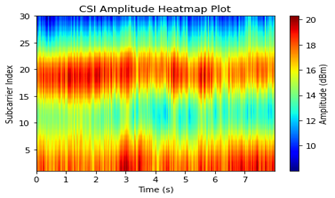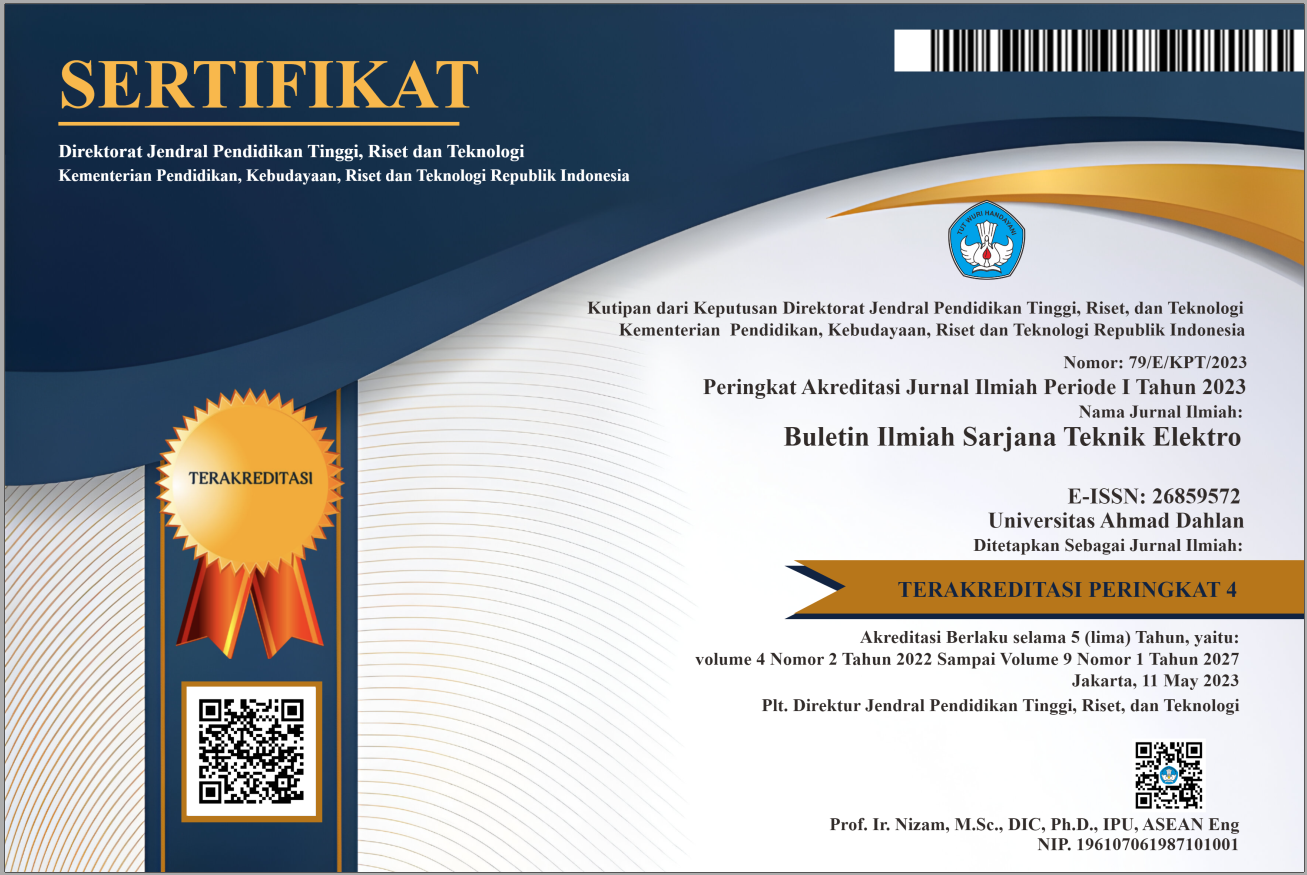Human Activity Recognition System Using WiFi Sensing and Deep Learning
DOI:
https://doi.org/10.12928/biste.v5i4.9408Keywords:
CSI, Deep Learning, Wi-FiAbstract
Human activity recognition systems can be used for various purposes such as monitoring, authentication, and telemedicine. In this research, a non-invasive, high privacy, easy to implement, and affordable human activity recognition system based on WiFi and deep learning is developed. Sixteen activities; including upper body, lower body, and whole body movement; were recognized by utilizing Channel State Information (CSI) contained in the WiFi signal. Measurements were carried out in an empty room with dimensions of 6*8 m with the distance between the transmitter and receiver being 1, 3 and 6 meters from the subject. Google Teachable Machine is used to recognize activities carried out. From the measurement result, the accuracy shows more than 97%. It is also evident that the further the measurement distance, the worse the recognition results. This is due to the increasing amount of noise in the radio channel as the distance increases.
References
B. Bordel, R. Alcarria, and T. Robles, “Recognizing human activities in Industry 4.0 scenarios through an analysis-modeling- recognition algorithm and context labels,” Integrated Computer-Aided Engineering, vol. 29, no. 1, pp. 83–103, 2021, https://doi.org/10.3233/ICA-210667.
F. Adib, H. Mao, Z. Kabelac, D. Katabi, and R. C. Miller, “Smart Homes that Monitor Breathing and Heart Rate,” in Proceedings of the 33rd Annual ACM Conference on Human Factors in Computing Systems, pp. 837–846, 2015, https://doi.org/10.1145/2702123.2702200.
A. Barua, M. A. Al Alamin, M. S. Hossain and E. Hossain, "Security and Privacy Threats for Bluetooth Low Energy in IoT and Wearable Devices: A Comprehensive Survey," in IEEE Open Journal of the Communications Society, vol. 3, pp. 251-281, 2022, https://doi.org/10.1109/OJCOMS.2022.3149732.
F. Serpush, M. B. Menhaj, B. Masoumi, and B. Karasfi, “Wearable Sensor-Based Human Activity Recognition in the Smart Healthcare System,” Computational Intelligence and Neuroscience, vol. 2022, pp. 1–31, 2022, https://doi.org/10.1155/2022/1391906.
Z. Yin, C. Wu, Z. Yang, and Y. Liu, “Peer-to-Peer Indoor Navigation Using Smartphones,” IEEE Journal on Selected Areas in Communications, vol. 35, no. 5, pp. 1141–1153, 2017, https://doi.org/10.1109/JSAC.2017.2680844.
S. K. Yadav, K. Tiwari, H. M. Pandey, and S. A. Akbar, “A review of multimodal human activity recognition with special emphasis on classification, applications, challenges and future directions,” Knowledge-Based Systems, vol. 223, p. 106970, 2021, https://doi.org/10.1016/j.knosys.2021.106970.
Z. Zhuang and Y. Xue, “Sport-Related Human Activity Detection and Recognition Using a Smartwatch,” Sensors, vol. 19, no. 22, p. 5001, 2019, https://doi.org/10.3390/s19225001.
D. R. Beddiar, B. Nini, M. Sabokrou, and A. Hadid, “Vision-based human activity recognition: a survey,” Multimedia Tools and Applications, vol. 79, no. 41-42, pp. 30509-30555, 2020, https://doi.org/10.1007/s11042-020-09004-3.
S. Mekruksavanich and A. Jitpattanakul, “Smartwatch-based Human Activity Recognition Using Hybrid LSTM Network,” in 2020 IEEE SENSORS, pp. 1–4, 2020, https://doi.org/10.1109/SENSORS47125.2020.9278630.
J. Berger and S. Lu, “A Multi-camera System for Human Detection and Activity Recognition,” Procedia CIRP, vol. 112, pp. 191–196, 2022, https://doi.org/10.1016/j.procir.2022.09.071.
Y. Lin, J. Le Kernec, S. Yang, F. Fioranelli, O. Romain, and Z. Zhao, “Human Activity Classification With Radar: Optimization and Noise Robustness With Iterative Convolutional Neural Networks Followed With Random Forests,” IEEE Sensors Journal, vol. 18, no. 23, pp. 9669–9681, 2018, https://doi.org/10.1109/JSEN.2018.2872849.
M. Chen et al., "Distributed Learning in Wireless Networks: Recent Progress and Future Challenges," in IEEE Journal on Selected Areas in Communications, vol. 39, no. 12, pp. 3579-3605, Dec. 2021, https://doi.org/10.1109/JSAC.2021.3118346.
A. Dubey, P. Sood, J. Santos, D. Ma, C. -Y. Chiu and R. Murch, "An Enhanced Approach to Imaging the Indoor Environment Using WiFi RSSI Measurements," in IEEE Transactions on Vehicular Technology, vol. 70, no. 9, pp. 8415-8430, 2021, https://doi.org/10.1109/TVT.2021.3101009.
W. Dib, K. Ghanem, A. Ababou, M. Nedil, and B. Eskofier, “Receive Signal Strength- Based Human Activity Recognition,” in 2021 IEEE International Symposium on Antennas and Propagation and USNC-URSI Radio Science Meeting (APS/URSI), pp. 365–366, 2021,https://doi.org/10.1109/APS/URSI47566.2021.9704667.
Y. Ma, G. Zhou, and S. Wang, “WiFi Sensing with Channel State Information,” ACM Computing Surveys, vol. 52, no. 3, pp. 1–36, 2020, https://doi.org/10.1145/3310194.
L. Guo et al., “Wiar: A Public Dataset for Wifi-Based Activity Recognition,” IEEE Access, vol. 7, pp. 154935–154945, 2019, https://doi.org/10.1109/ACCESS.2019.2947024.
G. Forbes, S. Massie and S. Craw, "WiFi-based Human Activity Recognition using Raspberry Pi," 2020 IEEE 32nd International Conference on Tools with Artificial Intelligence (ICTAI), pp. 722-730, , 2020, https://doi.org/10.1109/ICTAI50040.2020.00115.
M. Carney et al., “Teachable Machine: Approachable Web-Based Tool for Exploring Machine Learning Classification,” in Extended Abstracts of the 2020 CHI Conference on Human Factors in Computing Systems, pp. 1–8, 2020, https://doi.org/10.1145/3334480.3382839.
B. Juba and H. S. Le, “Precision-Recall versus Accuracy and the Role of Large Data Sets,” Proceedings of the AAAI Conference on Artificial Intelligence, vol. 33, no. 01, pp. 4039–4048, 2019, https://doi.org/10.1609/aaai.v33i01.33014039.
M. G. Moghaddam, A. A. N. Shirehjini, and S. Shirmohammadi, “A WiFi-Based Method for Recognizing Fine-Grained Multiple-Subject Human Activities,” IEEE Transactions on Instrumentation and Measurement, vol. 72, pp. 1–13, 2023, https://doi.org/10.1109/TIM.2023.3289547.
W. Huang, Y. Liu, S. Zhu, S. Wang, and Y. Zhang, “TSCNN: A 3D Convolutional Activity Recognition Network Based on RFID RSSI,” in 2020 International Joint Conference on Neural Networks (IJCNN), pp. 1–8, 2020, https://doi.org/10.1109/IJCNN48605.2020.9207590.
M. G. Moghaddam, A. A. N. Shirehjini, and S. Shirmohammadi, “A WiFi-based System for Recognizing Fine-grained Multiple-Subject Human Activities,” in 2022 IEEE International Instrumentation and Measurement Technology Conference (I2MTC), pp. 1–6, 2022, https://doi.org/10.1109/I2MTC48687.2022.9806622.

Published
How to Cite
Issue
Section
License
Copyright (c) 2023 Nazmia Kurniawati, Shita Fitria Nurjihan

This work is licensed under a Creative Commons Attribution-ShareAlike 4.0 International License.
Authors who publish with this journal agree to the following terms:
- Authors retain copyright and grant the journal right of first publication with the work simultaneously licensed under a Creative Commons Attribution License that allows others to share the work with an acknowledgment of the work's authorship and initial publication in this journal.
- Authors are able to enter into separate, additional contractual arrangements for the non-exclusive distribution of the journal's published version of the work (e.g., post it to an institutional repository or publish it in a book), with an acknowledgment of its initial publication in this journal.
- Authors are permitted and encouraged to post their work online (e.g., in institutional repositories or on their website) prior to and during the submission process, as it can lead to productive exchanges, as well as earlier and greater citation of published work (See The Effect of Open Access).
This journal is licensed under a Creative Commons Attribution-ShareAlike 4.0 International License.


